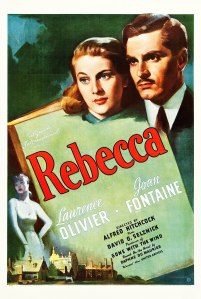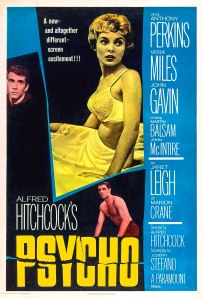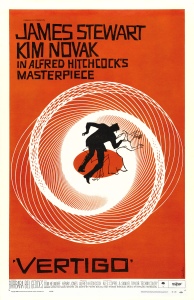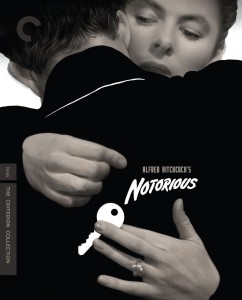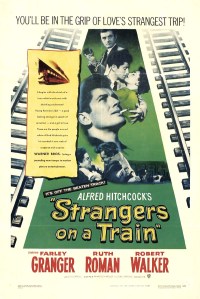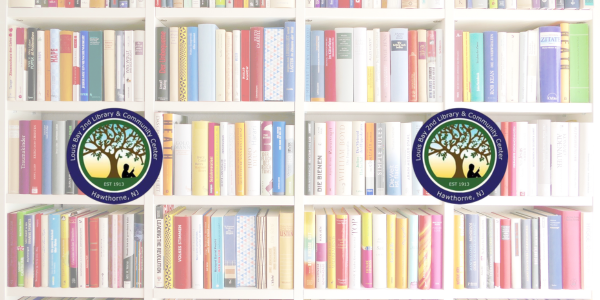Click the poster to request the movie!
Alfred Hitchcock was born on August 13, 1899 in London. He began his film career in 1920 and seven years later he moved to Hollywood, California. The first film that Hitchcock directed alone was created in 1925. Hitchcock was called the Master of Suspense because of his use of psychological elements throughout his films. In 1929, his first talking film was Blackmail and in 1948 his first color film was Rope. His films were nominated for 46 academy awards but only won 6 of them. He was nominated five times for best director but never won in that category. Alfred Hitchcock is one of the most influential filmmakers of all time.
- Rebecca (1940). Rebecca was released in 1940 and is based on the gothic novel Rebecca by Daphne Du Maurier. Hitchcock would again use Du Maurier’s short story The Birds as the basis of his 1963 film. The screenplay was written by Robert Sherwood and Joan Harrison. It stars Sir Laurence Olivier, Joan Fontaine, George Sanders, and Judith Anderson. The plot revolves around a young woman, who meets and quickly marries a fascinating man, the aristocratic widower Maxim de Winter. When she moves into the de Winter’s baroque estate Manderley, she is forced to live in the shadow of the first Mrs. de Winter, Rebecca. Rebecca mysteriously died a few years prior and her former maid compares Rebecca to the new Mrs. de Winter constantly. Similar to the book, the second Mrs. de Winter played by Joan Fontaine is never referred to by a first name. Rebecca is the first and only film Hitchcock made with producer David O. Selznick. Rebecca is also the only Hitchcock film to win best picture.
2. Psycho (1960). Psycho was released in 1960 and is arguably the most known Hitchcock film. Based on the book by Robert Bloch, it follows a Phoenix secretary who steals 40,000 dollars from her employer so she and her boyfriend can run away together. To outwit the police, she takes the back roads and stumbles upon the Bates Motel and the proprietor Norman Bates. The most famous scene in the film is the shower scene. The screenplay for the film was by Joseph Stefano and stars: Anthony Perkins, Janet Leigh, Vera Miles, John Gavin, and Martin Balsam. Psycho was nominated for Best Supporting Actress for Janet Leigh and for Best Director at the Oscars of 1961. It remains the highest grossing Hitchcock film.
3. Shadow of a Doubt (1943). Shadow of a Doubt was released in 1943 with the screenplay by Thornton Wilder (Playwright of Our Town), Sally Benson and Hitchcock’s wife Alma Reville. The film stars Tessa Wright, Joseph Cotton, Hume Cronyn, and Macdonald Carey. The plot of the film follows Charlie, who is overjoyed when her favorite Uncle Charlie comes for a visit. Slowly, she begins to suspect that her uncle is the Merry Widow Murderer who the authorities are after. This is Hitchcock’s personal favorite film. The film was shot in Santa Rose and was just far enough away from Hollywood so local residents could play the extras. SAG union had a requirement that movies shot around LA had to have professional union actors in all parts.
4. Rear Window (1954). Rear Window was released in 1954 and stars James Stewart, Grace Kelly, Wendell Corey, Raymond Burr, and Thelma Ritter. The film focuses on newspaper photographer LB Jefferies as he is held up in his apartment with a broken leg. To pass the time, he observes his neighbors through his back window. One night, he witnesses a murder and, with the help of his girlfriend and nurse, tries to solve it. Rear Window earned Hitchcock his fourth Oscar nomination for Best Director. Many film critics and entertainment workers believe that this is Hitchcock’s masterpiece along with it being one of the greatest films ever made. Grace Kelly and James Stewart appear in two other Hitchcock films: Kelly in Dial M for Murder and To Catch a Thief with Cary Grant and Stewart in The Man Who Knew Too Much and Rope.
5. Vertigo (1958). Vertigo was released in 1958 and stars James Stewart, Kim Novak, Barbara Bel Geddes, and Tom Helmore. Detective John “Scottie” Ferguson goes into an early retirement after a rooftop chase leads to the death of an officer and forms Scottie’s fear of heights which causes him to have Vertigo. He is hired by a friend to prevent his wife from committing suicide. After the death, Scottie sees a double of the woman leading to a cycle of lies and madness. The film’s second cameraman is created for the dolly zoom aka the Vertigo Effect. This is the only film to be in the top 10 Best Movies of All Time list according to the American Film Institute. In 2012, the British Film Institute’s Sight and Sound 100 Greatest Films of All Time named Vertigo to be the best, knocking Citizen Kane to number 2.
6. Notorious (1946). Notorious was released in 1946 with the screenplay by Ben Hecht and stars Cary Grant, Ingrid Bergman, Claude Rains, Louis Calhem. A brief synopsis: In Brazil, U.S. agent Delvin recruits the daughter of a German War criminal, Alicia Huberman, as a spy. They soon start to fall in love but Delvin says she needs to win over a Nazi in hiding, Alexander Sebastian. This is the second Hitchcock film Grant was in, the other two films that are not on this list are Suspicion and To Catch a Thief with Grace Kelly. This is also Bergman’s second film, her other Hitchcock credits are Spellbound and Under Capricorn.
7. North by Northwest (1959). North by Northwest was released in 1959 and is shot in technicolor. The screenplay is by Ernest Lehman and stars Cary Grant, Eva Marie Saint, James Mason, Leo G. Carroll, and Martin Landau. A brief synopsis: Roger Thornhill is being pursued by spy Philip Vandamm after being mistaken for a government agent. Thornhill goes on a cross country journey to try and outrun Vandamm and along the way meets Eve Kendall. Fun fact: Hitchcock and Lehman were supposed to be making another film but thought that movie script would not work so instead they came up with North by Northwest.
8. Strangers on the Train (1951). Strangers was released in 1951 and is adapted from Patricia Highsmith’s debut thriller of the same name. The movie does not incorporate everything from Highsmith’s book. It stars Robert Walker, Farley Granger, Ruth Roman, Leo G. Carroll, and Patricia Hitchcock. Czenzi Ormonde, Alma Reville, and Barbara Keon wrote the screenplay. Raymond Chandler’s name appears on the official list of screenplay writers but after Chandler’s second draft of the script didn’t sit well with Hitchcock, the two parted ways. Warner Brothers wanted to use Chandler’s name to get movie goers into the theaters. A brief synopsis: Tennis star Guy Haines is outraged that his wife is refusing to finalize their divorce so that he can marry the senator’s daughter. On a train, Guy meets Bruno Anthony and unwittingly sets off a chain of events. Discovering that Anthony is a psychopath, Guy finds out that he murdered his wife and now accepts Guy to hold up his end of their bargain. However, Guy finds himself the prime suspect in his wife’s murder. Fun Fact: Carol Burnett’s star on the Hollywood Walk of Fame is located near the Hollywood Pacific theater where she used to work in college when Strangers on the Train was showing.
9. The 39 Steps (1935). The 39 Steps was released in 1935 and is loosely based on the novel The 39 Steps by John Buchan. It stars Robert Donat, Madeline Carroll, Godfrey Tearle, and Lucie Mannheim. This film follows Richard Hannay as he stumbles onto a conspiracy that thrusts him into a hectic chase through the Scottish Moors.
10. The Lady Vanishes (1938). Lady Vanishes was released in 1938 and stars Margaret Lockwood, Michael Redgrave, May Whitty, and Paul Lukas. A train heading for England is caught by an avalanche. Lockwood’s character Iris befriends an elderly woman Miss Foy when the train passengers are put up in a hotel for the evening. When the train resumes its journey, Iris finds out that Miss Foy has disappeared. Iris is even more shocked that the other passengers begin to say that they never had seen Miss Foy on the train at all. Iris, along with another passenger, investigate the train. This was the first film that Michael Redgrave made. Vivien Leigh was considered for the role of Iris before casting Margaret Lockwood.
Written by Jane Spadaccini, Adult Service

